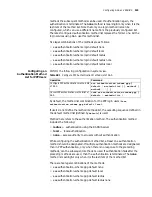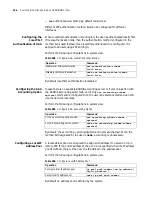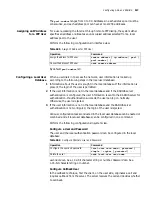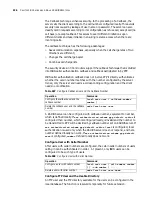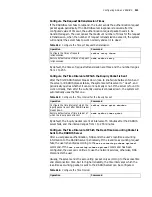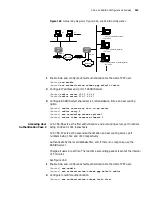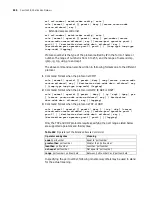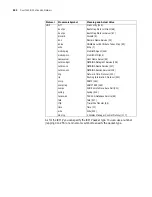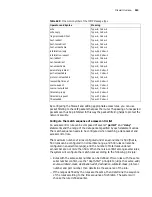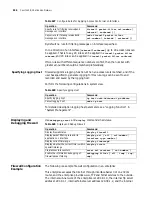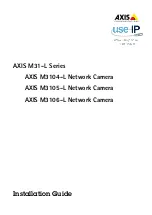
548
C
HAPTER
39: C
ONFIGURING
F
IREWALL
Classification of Firewalls
Usually firewalls are divided into two types: network layer firewalls and application
layer firewalls. A network layer firewall mainly obtains the packet head
information of data packets, such as protocol number, source address and source
port, destination address and destination port, or directly obtains the data of a
packet head. But an application layer firewall analyzes the whole information
stream.
Commonly used firewalls include the following:
■
Application Gateway: checks the application layer data of all data packets
passing through this gateway. For example, the FTP application gateway will be
a FTP server to a connected client end, but will be an FTP dlient to the server
end. All FTP data packets transmitted on the connection must pass through this
FTP application gateway.
■
Packet Filtering: filters each data packet using the user-defined items. For
example, to check if the source address and destination address of a data
packet meet the rules.
Packet filtering does not check call status, nor does it
analyze the data. If data packets with port 21 or greater than or equal to 1024
are allowed to pass, then once a port meets this condition, the data packet can
pass this firewall. If the rules are configured, then many data packets with
hidden security troubles can be filtered out on this layer.
■
Proxy: normally refer to address proxy on a proxy server or a router. It replaces
the IP address and port of a host inside the network with the IP address and
port of a server or router. For example, the intranet address of an enterprise is
129.0.0.0 network segment, and its formal external IP address is
202.38.160.2-202.38.160.6. When the internal host 129.9.10.100 accesses a
certain external server in WWW mode, the IP address and port might become
202.38.160.2:6080 after passing through the proxy server. An address
mapping table is maintained in the proxy server. When the external WWW
server returns the result, the proxy server will convert this IP address and port
into the internal IP address and port 80 of the network. The proxy server is used
so that all access between the external network hosts and the internal network
occurs through this proxy server. In this way, the access to internal devices that
contain important resources can be controlled.
Packet Filtering
Usually, packet filtering refers to filtering for IP data packets forwarded. For the
data packets that need to be forwarded by a router, first the packet header
information, including the number of the upper layer protocol carried by the IP
layer, the packet's source/destination address and source/destination port is
obtained. Then the information is compared with the set rules. Finally, it is decided
whether to transfer or discard the data packet according to the comparison result.
Packet filtering (for IP data packets) selects the following elements for judgment
(in the figure, the upper layer protocol carried by IP is TCP), as shown in the figure
below.
Summary of Contents for 3036
Page 1: ...http www 3com com 3Com Router Configuration Guide Published March 2004 Part No 10014299 ...
Page 4: ...VPN 615 RELIABILITY 665 QOS 681 DIAL UP 721 ...
Page 6: ...2 ABOUT THIS GUIDE ...
Page 7: ...I GETTING STARTED Chapter 1 3Com Router Introduction Chapter 2 3Com Router User Interface ...
Page 8: ...4 ...
Page 16: ...12 CHAPTER 1 3COM ROUTER INTRODUCTION ...
Page 34: ...30 ...
Page 60: ...56 CHAPTER 3 SYSTEM MANAGEMENT ...
Page 98: ...94 CHAPTER 6 DISPLAY AND DEBUGGING TOOLS ...
Page 110: ...106 ...
Page 114: ...110 CHAPTER 8 INTERFACE CONFIGURATION OVERVIEW ...
Page 158: ...154 CHAPTER 10 CONFIGURING WAN INTERFACE ...
Page 168: ...164 ...
Page 188: ...184 CHAPTER 13 CONFIGURING PPPOE CLIENT ...
Page 192: ...188 CHAPTER 14 CONFIGURING SLIP Router ip route static 0 0 0 0 0 0 0 0 10 110 0 1 ...
Page 248: ...244 CHAPTER 16 CONFIGURING LAPB AND X 25 ...
Page 320: ...316 ...
Page 330: ...326 CHAPTER 20 CONFIGURING IP ADDRESS ...
Page 362: ...358 CHAPTER 21 CONFIGURING IP APPLICATION ...
Page 374: ...370 CHAPTER 23 CONFIGURING IP COUNT ...
Page 406: ...402 CHAPTER 25 CONFIGURING DLSW ...
Page 408: ...404 ...
Page 452: ...448 CHAPTER 29 CONFIGURING OSPF ...
Page 482: ...478 CHAPTER 30 CONFIGURING BGP ...
Page 494: ...490 CHAPTER 31 CONFIGURING IP ROUTING POLICY ...
Page 502: ...498 ...
Page 508: ...504 CHAPTER 33 IP MULTICAST ...
Page 514: ...510 CHAPTER 34 CONFIGURING IGMP ...
Page 526: ...522 CHAPTER 36 CONFIGURING PIM SM ...
Page 528: ...524 ...
Page 532: ...528 CHAPTER 37 CONFIGURING TERMINAL ACCESS SECURITY ...
Page 550: ...546 CHAPTER 38 CONFIGURING AAA AND RADIUS PROTOCOL ...
Page 590: ...586 CHAPTER 40 CONFIGURING IPSEC ...
Page 599: ...IX VPN Chapter 42 Configuring VPN Chapter 43 Configuring L2TP Chapter 44 Configuring GRE ...
Page 600: ...596 ...
Page 638: ...634 CHAPTER 43 CONFIGURING L2TP ...
Page 649: ...X RELIABILITY Chapter 45 Configuring a Standby Center Chapter 46 Configuring VRRP ...
Page 650: ...646 ...
Page 666: ...662 ...
Page 670: ...666 CHAPTER 47 QOS OVERVIEW ...
Page 700: ...696 CHAPTER 49 CONGESTION MANAGEMENT ...
Page 706: ...702 CHAPTER 50 CONGESTION AVOIDANCE ...
Page 707: ...XII DIAL UP Chapter 51 Configuring DCC Chapter 52 Configuring Modem ...
Page 708: ...704 ...
Page 762: ...758 CHAPTER 52 CONFIGURING MODEM ...


